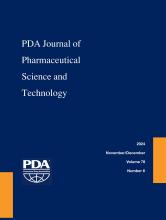Abstract
Leachables in drug products and from medical devices can adversely affect patient health and thus must be identified and quantified. Accurate and protective quantitation in target analysis for leachables (and extractables as potential leachables) is accomplished via compound-specific calibration curves. Quantification in non-targeted analysis (NTA) is complicated by the variable relative response factors (RRFs) among and between individual leachables and the circumstance that the leachables are not known until the NTA is completed. Protective quantitation in NTA is accomplished in various ways, depending on the identification status of the analyte. When an analyte’s identity is confirmed, it is quantified using the compound’s own RRF, obtained by analysis of a reference standard. In other identification circumstances, the concentration is calculated using a surrogate response, either linked to a surrogate compound or representative of a domain of leachables. Given the difficulty in matching an analyte with a proper surrogate, this article addresses quantitation via the latter approach. This article uses a database of >3000 GC/MS response factors to empirically divide the population of leachables into response factor domains, differentiated by either the analyte’s polarity (log Po/w) or retention time. Using the database, mean RRF values and uncertainty factors (UFs) are established for each domain and are used for quantitation. Protective quantitation is accomplished for nearly 84% of all leachables in the database (and presumably the entire population) by placing an analyte into its proper domain and then using the mean RRF divided by the UF for that domain as a universal response factor for all compounds in the domain.
- © PDA, Inc. 2024
PDA members receive access to all articles published in the current year and previous volume year. Institutional subscribers received access to all content. Log in below to receive access to this article if you are either of these.
If you are neither or you are a PDA member trying to access an article outside of your membership license, then you must purchase access to this article (below). If you do not have a username or password for JPST, you will be required to create an account prior to purchasing.
Full issue PDFs are for PDA members only.
Note to pda.org users
The PDA and PDA bookstore websites (www.pda.org and www.pda.org/bookstore) are separate websites from the PDA JPST website. When you first join PDA, your initial UserID and Password are sent to HighWirePress to create your PDA JPST account. Subsequent UserrID and Password changes required at the PDA websites will not pass on to PDA JPST and vice versa. If you forget your PDA JPST UserID and/or Password, you can request help to retrieve UserID and reset Password below.






